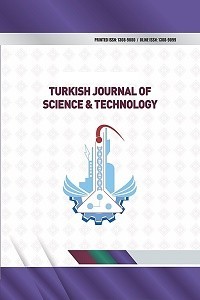Energy and Exergy Analysis of Drying Behavior for a Fish
Energy and Exergy Analysis of Drying Behavior for a Fish
Enerji, Ekserji, Taşınımlı kurutucu,
___
- Erdem M, Öztop HF, Varol Y, Kamışlı F. Tepsili bir kurutucuda kurutulan alabalığın üzerinde hava giriş sıcaklığı etkisinin deneysel olarak incelenmesi. Dicle Üniversitesi 2. Anadolu Enerji Sempozyumu, (2-4 Mayıs 2013) Bildirileri, H. Bayındır (Editor), Diyarbakır, 2013: 741-745.
- Erdem M. Balığın tepsili kurutucuda kurutma davranışının deneysel olarak incelenmesi. Yüksek Lisans Tezi, Fırat Üniversitesi Fen Bilimleri Enstitüsü 2011; 67s.
- Erdem M, Varol Y. Alabalığın kurutulması ve tuzlanması üzerine deneysel bir çalışma. Termodinamik Dergisi 2014; 264: 92-102.
- Erdem M, Varol Y, Öztop HF, Türkbay İ. Balığın Kuruma Davranışı Üzerinde Parça Etkisi ve Sistemin Enerji Gereksiniminin İncelenmesi. Fırat Üniversitesi Mühendislik Bilimleri Dergisi 2016; 28 (2): 89-98.
- Midilli A, Kucuk.H. Energy and exergy analysis of solar drying process of pistachio. Energy 2003; 28:.539-556.
- Prommas R, Rattanadecho P, Cholaseuk D. Energy and exergy analysis in drying process of porous media using hot air, Int. commun Heat Mass Transfer 2010: 37, 372-378.
- Akpinar EK, Midilli A, Bicer Y. Energy and exergy of potato drying process via cyclone type dryer. Energy Conver Manag 2005: 46; 2530-2552.
- Akpinar EK. Energy and exergy analyses of drying of red pepper slices in a convective type dryer. Int commun in Heat Mass Transfer. 2004: 31; 1165-1176.
- Dincer I, Sahin AZ. A new model for thermodynamic analysis of a drying process. Int J Heat Mass Transfer. 2004; 47: 645-652.
- Corzo O, Bracho N, Vasgues A, Pereira A. Energy and exergy analyses of thin layer drying of coroba slices. J Food Eng. 2008; 86: 151-161.
- Buolemtafes-Boukadoum A, Benzaoui.A. Energy exergy analysis of solar drying of mint. Energy Procedia 2011; 6: 583-591.
- Akpinar EK, Midilli A, Bicer Y. The first and second law analyses of thermodynamic of pumpkin drying process. J Food Engineer 2006; 72: 320-331.
- Aghbashlo M, Mobli H, Rafiee S, Madadlou A. Energy and exergy analyses of the spray drying process of fish oil microencapsulation. Biosystems Engineer 2012; 111: 229-241.
- Colak N, Hepbasli A. Performance analysis of drying of green olive in a tray dryer. J Food Engineer 2007; 80: 1188-1193.
- Gokoglu N. Aquatic products processing technology. Istanbul, Turkey 2002.
- Cengel YA, Boles MA. Thermodynamics: An engineering approach. McGraw-Hill, Inc.New York 1994.
- Bejan A. Advanced Engineering Thermodynamics. John Wiley and Sons, New York 1998.
- Ahern JE. The exergy method of energy systems analysis. John Wiley, New York 1980.
- Holman J. Experimental methods for engineers, second edition. McGraw-Hill New York 1994.
- ISSN: 1308-9080
- Başlangıç: 2009
- Yayıncı: Fırat Üniversitesi
Enhancing The Data Security by using Audio Steganography with Taylor Series Cryptosystem
Modelling a Static VAr Compensator consist of TCR and TSC
M3 (δ0)⊂E2 4 9 3-Uzayında non-Dejenere Eğriler Tarafından Elde Edilen Helis ve Slant Helisler
One-dimensional Center Symmetric Local Binary Pattern Based Epilepsy Detection Method
Muhammed YILDIRIM, Ahmet ÇINAR
-Performance of Chaotic Mapping Multi-Objective Optimization Algorithms
Correlation Based Regression Imputation (CBRI) Method for Missing Data Imputation
A methodology for implementation of the mechanistic-empirical rigid pavement design in Turkey
Mohammad Razeq SHAKHAN, Ali TOPAL, Burak ŞENGÖZ
4×4 Knight’s Graph Analysis by Modularity A Knight Graph Application
